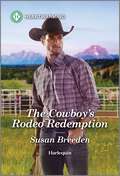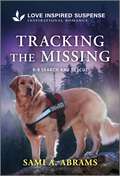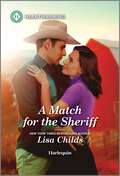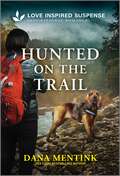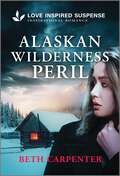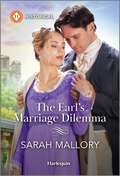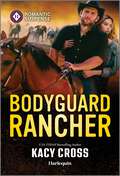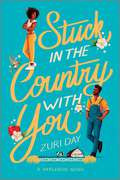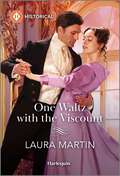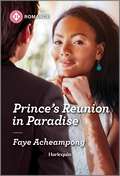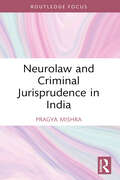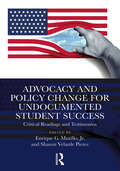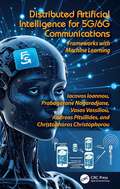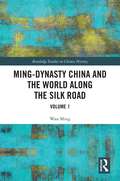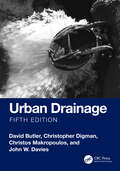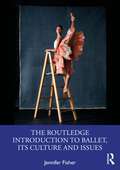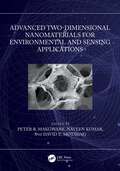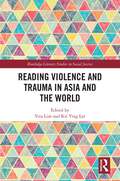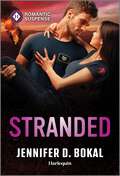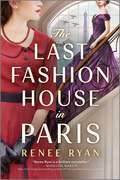- Table View
- List View
The Cowboy's Rodeo Redemption (Destiny Springs, Wyoming)
by Susan BreedenHis cowgirl crush is back…But will she stay? Between reviving his ranch in Destiny Springs, Wyoming, and raising his twin girls, Nash Buchanan&’s life seems full to bursting. But there&’s something missing. Jess McCoy, his former barrel-racing student—and unrequited crush—walked away without a word ten years ago. Now she&’s back, a widowed mom who will face any challenge—including her own wounded heart—to convince Nash to coach her young daughter. But Nash is done with rodeo. Can they come to an agreement that will heal the rift between them…and give their love a second chance?Destiny Springs, WyomingFrom Harlequin Heartwarming: Wholesome stories of love, compassion and belonging.Destiny Springs, WyomingBook 1: The Bull Rider's Secret SonBook 2: Her Kind of CowboyBook 3: The Cowboy's Rodeo RedemptionBook 4: And Cowboy Makes Three
Tracking the Missing (K-9 Search and Rescue)
by Sami A. AbramsA search for three abducted teens— and a K-9 on the case. After surviving a vicious attack in the woods, Tori Campbell awakes to her worst nightmare—her son and his two friends are missing. She calls the one person she knows she can trust, her late husband&’s best friend, former DEA agent Michael Lane. Together with his search-and-rescue K-9, they must track the boys and figure out who took them—and why. Only, the Indiana wilderness is full of dangers beyond their abductor. Can Michael and Tori find the teens…even if it means falling into a sinister trap?From Love Inspired Suspense: Courage. Danger. Faith.K-9 Search and Rescue Book 1: Desert Rescue by Lisa PhillipsBook 2: Trailing a Killer by Carol J. PostBook 3: Mountain Survival by Christy BarrittBook 4: Search and Defend by Heather WoodhavenBook 5: Following the Trail by Lynette EasonBook 6: Dangerous Mountain Rescue by Christy BarrittBook 7: Wilderness Hunt by Lisa PhillipsBook 8: Alaskan Mountain Search by Sarah VarlandBook 9: Alaskan Avalanche Escape by Darlene L. TurnerBook 10: Tracking Stolen Treasures by Lisa PhillipsBook 11: Alaskan Wilderness Rescue by Sarah VarlandBook 12: Lethal Mountain Pursuit by Christy BarrittBook 13: Tracking the Missing by Sami A. AbramsBook 14: K-9 Alaskan Defense by Sarah VarlandBook 15: Searching for Justice by Connie Queen
A Match for the Sheriff: A Clean and Uplifting Romance (Bachelor Cowboys)
by Lisa ChildsThe sheriff vows to find the truth…But will it be worth the cost? Sheriff Marsh Cassidy suspects his dad&’s nurse, Sarah Reynolds, knows something about the fire at his family ranch. It's his job and his family duty to find the truth, but he&’s torn between finding answers and his growing feelings for Sarah and little Mikey. Sarah would do anything to protect her son, and it&’ll take more than a white hat to gain her trust. When the truth about the fire finally comes out, will Marsh and Sarah lose everything…or find a way to have it all?Bachelor CowboysNew York Times Bestselling Author Lisa ChildsFrom Harlequin Heartwarming: Wholesome stories of love, compassion and belonging.Bachelor CowboysBook 1: A Rancher's PromiseBook 2: The Cowboy's Unlikely MatchBook 3: The Bronc Rider's Twin SurpriseBook 4: The Cowboy's Ranch RescueBook 5: The Firefighter's Family SecretBook 6: The Doc's Instant FamilyBook 7: The Rancher's ReunionBook 8: A Match for the Sheriff
Hunted on the Trail (Security Hounds Investigations)
by Dana MentinkA killer out for vengeance… but this bloodhound has his scent. Ambushed by sudden gunfire, former cop Stephanie Wolfe realizes the tracking competition she entered with her bloodhound is a setup. An escaped fugitive has lured her into the remote wilderness to exact his deadly revenge. And her ex-boyfriend, bounty hunter Vance Silverton, has fallen into the fatal trap, too. Now cut off from civilization with only minimal supplies and their two dogs, the pair must depend on each other to survive. But with a treacherous storm approaching, it&’s not only a cold-blooded killer they&’ll have to escape.From Love Inspired Suspense: Courage. Danger. Faith.Security Hounds Investigations Book 1: Tracking the TruthBook 2: Fugitive SearchBook 3: Hunted on the Trail
A Hawaiian Christmas Romance: A Clean and Uplifting Romance (Hawaiian Reunions)
by Anna J. StewartIs opening her heart…The best gift of all? Hawaiian sunsets with her good friend and next door neighbor Wyatt Jenkins help Tehani Iokepa get through each day as a single mom. With his lighthearted nature and touching bond with her son, Wyatt always lifts Tehani&’s mood. But as two-month-old Kai&’s first Christmas approaches, memories of her husband are everywhere. Working together to save the Santa Surfing Championship makes Tehani realize she&’s ready to create new memories…with Wyatt. But guilt and loyalty keep them both from sharing their true feelings. Can their hearts take the leap from friendship to love this Christmas?Hawaiian ReunionsUSA TODAY BESTSELLING AUTHORFrom Harlequin Heartwarming: Wholesome stories of love, compassion and belonging.Hawaiian ReunionsBook 1: Her Island HomecomingBook 2: Their Surprise Island WeddingBook 3: A Surprise Second ChanceBook 4: A Hawaiian Christmas RomanceBook 5: The Single Dad's Promise
Alaskan Wilderness Peril
by Beth CarpenterInside a valuable antique is a secret worth killing for… Antiques dealer Hannah Yates discovers an incredibly rare globe decorated with inlaid markings only to become the target of thieves who are growing increasingly more threatening. Someone wants this globe at any cost, and nowhere—even the remote Alaskan cabin of her former crush, Jace Angeles—is safe. On the run through the rugged wilderness, Hannah and Jace are forced to make one daring escape after another. But can they unlock the secrets of the globe…before they end up paying the ultimate price?From Love Inspired Suspense: Courage. Danger. Faith.
Secret Fling with the Billionaire
by Michelle DouglasIn Michelle Douglas&’s latest Harlequin Romance novel, an actress and former wild child discovers eluding the press is far easier than hiding her growing feelings for the world-famous thriller author she&’s been lying low with… THE THRILL OF FALLING… After a humiliatingly public breakup, actress Cleo dives onto a boat to evade the press—and comes face-to-face with its grumpy owner! Only, her reluctant rescuer is as attractive as he is guarded, quickly putting Cleo&’s vow to swear off men to the test… Famously reclusive thriller author Jude Blackwood has experience being hounded by the media, so the billionaire begrudgingly offers his beautiful stowaway sanctuary. Yet being in such close proximity proves more dangerous than the paparazzi…because their chemistry is inescapable! And a secret fling? Inevitable. But it&’s when they catch feelings that they&’re in real trouble!From Harlequin Romance: Be swept away by glamorous and heartfelt love stories.
The Earl's Marriage Dilemma
by Sarah MalloryDuty and desire collide for the earl in this compelling Regency romance!Hired by the earl…Desired as his bride? Conham, the new Earl of Dallamire, is resolute: he must wed a wealthy bride. It&’s the only way to bring the estate that his late father squandered back into prosperity. But a late-night encounter with beautiful stranger Rosina Brackwood leads Conham to question his carefully laid plans… Running away from her abominable brother, Rosina is in desperate need of refuge. So when Conham offers her the position of his land steward, it&’s an offer she can&’t refuse. Yet as they live and work in close confines, the crackle of chemistry is impossible to ignore…From Harlequin Historical: Your romantic escape to the past.
Bodyguard Rancher (The Secrets of Hidden Creek Ranch)
by Kacy CrossIt&’s his job to protect her Will she let him? A former navy SEAL, Heath McKay knows how to stay cool in life-and-death situations. Keeping Charli Lang safe while archaeologists dig up the treasure buried on her ranch should be easy. But Charli might prove to be more than he can handle. She doesn&’t want a bodyguard, even one posing as an undercover rancher, and she&’s as captivating as she is contrary. Wagering that he can change her mind within three weeks seems like the perfect way to keep her close—until their romantic sparring starts to feel like the real thing….From Harlequin Romantic Suspense: Danger. Passion. Drama.Feel the excitement in these uplifting romances, part of The Secrets of Hidden Creek Ranch series:Book 1: Undercover Cowboy ProtectorBook 2: Bodyguard RancherBook 3: Decoding Danger
Stuck in the Country with You: A Spicy Small Town Western Romance
by Zuri DayGood fences make good neighbors—except when a scorching shared past makes things complicated—in this delightful city-meets-country romance from Zuri Day.She&’s packing her bags—and her baggage. Ten years ago, Genesis Washington made a very poor decision. At the time, it seemed great. Fantastic. Explosive. But the truth is, your one-night rebound should never be your younger brother&’s rival. And he definitely shouldn&’t be someone who allegedly only slept with you to gain the upper hand—even if the sex was amazing. Now Genesis is blindsided when the farm she&’s inherited just happens to be right next door to Jaxson King, the regrettable one-night stand she&’s still painfully attracted to. This man has aged like the finest of wines, and what&’s worse, he&’s now a thoughtful and responsible father. Good thing Genesis has a (*cough* long-distance *cough*) boyfriend. Well, sort of. It&’s complicated. Jaxson and his hotness should be easy enough to ignore. But when city-girl Genesis discovers there&’s a serious learning curve to her humble new home, it&’s Jaxson who&’s there to lend a very skilled helping hand. With every problem that arises, Jaxson is seemingly making all the right moves—both on the farm and when things heat up behind closed doors. But, surely, that doesn&’t mean he&’s right for Genesis, does it? From showing up to glowing up, the characters in Afterglow Books are on the path to leading their best lives and finding sizzling romance along the way. Don&’t miss any of these other fun titles…Frenemy Fix-Up by Yahrah St. JohnThe Devil in Blue Jeans by Stacey KennedyOut of Office by A.H. CunninghamChurch Girl by Naima Simone
One Waltz with the Viscount (The Cinderella Shepherd Sisters)
by Laura Martin"Martin begins her 'Cinderella Shepherd Sisters' series with this steamy forbidden love historical romance."— Library JournalCinderella&’s accidental waltz…With the viscount everyone wants!Nothing will stop destitute Miss Sarah searching for her sister—even breaking into an exclusive ball in London! Fortunately, sneaking in through the window lands her in the arms of a dashing viscount!Henry&’s tedious evening among the ton becomes a lot more interesting when he decides to assist Sarah. His title might weigh heavy on his shoulders, but it can open doors. Yet time spent with the very unsuitable Sarah, when he&’s meant to be securing a suitable bride, soon finds them on the brink of scandal!From Harlequin Historical: Your romantic escape to the past.The Cinderella Shepherd SistersBook 1: One Waltz with the Viscount
Royally Forbidden to the Boss
by Scarlett ClarkeA runaway princess&’s growing connection with her billionaire boss threatens to unravel her new life away from the crown in Scarlett Clarke&’s latest Harlequin Romance novel! TRADING A TIARA FOR TEMPTATION… Princess Eviana escaped her kingdom and life in the limelight for Edinburgh with one goal: anonymity! Yet when she&’s hired by billion-dollar hedge fund manager Shaw Harrington, she feels like she&’s caught in the spotlight of his piercing gaze. Working together means a relationship is forbidden, but Shaw&’s undivided attention makes Eviana feel things she never imagined possible inside the castle walls… Only, having been betrayed once before, closed-off Shaw despises secrets. So with the unknown truth of Eviana&’s identity between them, their attraction can&’t go further than lingering looks across the boardroom… Can it?From Harlequin Romance: Be swept away by glamorous and heartfelt love stories.
River Wild (A Powder River Novel)
by B.J. DanielsEveryone has a secret. Some of them are deadly… Some scars can&’t be hidden. Sheriff Stuart Layton has plenty of those, courtesy of an attack that left him doubting himself as a lawman. But in Bailey McKenna he recognizes a different kind of hurt. That unspoken understanding has him opening his door to the mysterious, elusive young woman again and again, hoping she&’ll tell him what she&’s running from. Bailey has spent years searching for the rancher who put her through hell. She never saw his face, but she&’s convinced he&’s somewhere in Powder River. Now, suddenly, she has terrifying proof of how close he is. This time, Stuart is by her side, determined to protect her—and find retribution for himself. But will that be enough to fend off a killer waiting to finish what he started?A Powder River NovelBook 1: Dark Side of the RiverBook 2: River StrongBook 3: River JusticeBook 4: River Wild
Prince's Reunion in Paradise
by Faye AcheampongWhat happens when a pop princess is reunited with her childhood pen pal—a dreamy prince!—in the Maldives? Find out in Faye Acheampong&’s latest Harlequin Romance! POP PRINCESS TO FUTURE QUEEN? Crown Prince Dorian&’s Maldives holiday was supposed to be an escape. But he soon discovers that even paradise isn&’t problem-free when he&’s unexpectedly reunited with Damica Foye—retired pop star and his childhood pen pal. As a teenager, Dorian found solace in Damica&’s understanding of the pressure that being in the limelight creates. Then duty called for Dorian, fame became too much for Damica to bear and their bond began to break… Now, stuck on an island, will they claim their second chance and, this time, build more than just a friendship?From Harlequin Romance: Be swept away by glamorous and heartfelt love stories.
Neurolaw and Criminal Jurisprudence in India
by Pragya MishraThis work explores the transformative potential of neuroscience in reshaping India's criminal justice system. It deftly navigates the complex terrain of neurolaw, examining its implications for criminal responsibility, rehabilitation, and the very foundations of legal thought. Drawing on cutting-edge neuroscientific research and India's rich philosophical traditions, the work proposes innovative approaches to longstanding legal and ethical dilemmas. It covers a wide range of topics with depth and nuance, from a neurocriminological audit of Indian criminal codes to an exploration of neuroplasticity in offender rehabilitation. It includes a fascinating case study of the Vipassana meditation program in Indian prisons, illustrating the practical applications of neurolaw principles. The volume promises to spark crucial conversations about the nature of human behavior, the purpose of punishment, and the possibility of a more humane and effective justice system. It is a bold step toward a neuroscience-informed jurisprudence that honors both scientific truth and human dignity. At the intersection of neuroscience, law, and Indian philosophy, the work offers a unique perspective on some of the most pressing questions in modern jurisprudence. Representing a significant contribution to the global discourse on neurolaw and offering concrete suggestions for legal reform, judicial practice, and policymaking, it will be an essential read for legal scholars, neuroscientists, policymakers, and anyone interested in the future of criminal justice.
The Embarrassment of Being Human: A Critical Essay on the New Materialisms and Modernity in an Age of Crisis
by Benjamin BoysenWith the message that everything in a sense is alive, thus allowing us to join forces with new politico-ethical communities stretching across human and nonhuman realms, the new materialisms have captivated the minds of many academics, artists, and intellectuals by stressing that it is time to return to a premodern mindset and discard modernity and its concepts of secularization, autonomy, and finitude.The Embarrassment of Being Human not only demonstrates how these magical materialisms are beset by grave theoretical and practical inconsistencies and self-contradictions. It also demonstrates how their demand for humans to step down and allow for an emancipation of things qualifies the new materialisms as a metaphysics of neoliberalism that reproduces and fortifies the self-contradictions rampant in the current neoliberal hegemony.While helping us to gain a comprehensive understanding of the tenets of the eerie ills of our epoch, the critique of the new materialisms can furthermore inspire us to appreciate how the exact inversion of the new materialist complex amounts to a revitalization of the modern project. A revitalization that is critical to think our epoch differently.
Advocacy and Policy Change for Undocumented Student Success: Critical Readings and Testimonios
by Enrique G. Murillo Sharon Velarde PierceAdvocacy and Policy Change for Undocumented Student Success is a compelling exploration of the undocumented student experience in America, offering a deep dive into the advocacy, education, and systemic challenges faced by undocumented communities.Compiling the most significant work in the field in terms of its contributions to research and professional practice, this volume uncovers the historical struggles and triumphs of undocumented students and their families in their quest for educational access and equity. From pivotal legal milestones to personal narratives of resilience and adversity, this collection paints a comprehensive picture of the ongoing battle against legal and societal barriers. It delves into the mental health impacts of living undocumented and presents innovative strategies and policy reforms aimed at bridging the gap between harsh realities and hopeful aspirations. A clarion call to action, this volume is an invitation to join the fight for a more equitable and inclusive society, recognizing the vital contributions of undocumented individuals and advocating for systemic change.Advocacy and Policy Change for Undocumented Student Success is a must-have resource for graduate students and researchers in Educational Leadership and Policy, Multicultural Education, and Teacher Education. It will also be an important reading for educational leaders, teachers, counselors, administrators, and organizations that share a common interest in and commitment to the educational issues that impact undocumented students and their families.
Distributed Artificial Intelligence for 5G/6G Communications: Frameworks with Machine Learning
by Christophoros Christophorou Andreas Pitsillides Iacovos Ioannou Prabagarane Nagaradjane Vasos VassiliouThe aim of this book is to delineate the challenges faced by new generation mobile networks, such as 5G and forthcoming 6G, and introduce the concept of addressing these challenges through the development of a novel Distributed AI (DAI) framework. The book proposes a distributed AI approach to handle these complexities effectively.Distributed Artificial Intelligence for 5G/6G Communications: Frameworks with Machine Learning aims to provide a comprehensive understanding of the proposed DAI framework, its architecture, implementation, and application in the context of D2D communication in 5G and beyond networks. It showcases how the framework can enhance decision-making, control, and communication performance while considering both static and dynamic network environments. The book delves into the advantages of D2D communication, highlighting how it transcends licensed frequency bands and bypasses the cellular network, leading to improved network metrics such as spectral efficiency, energy efficiency, data rates, and interference management. It concludes by emphasizing that the DAI framework can offer enhanced network control, reduced signaling overhead, and efficient decision-making while capitalizing on existing implementations to tackle various challenges across the 5G and 6G landscape.This book is intended for professionals that specialize in designing, implementing, and maintaining communication networks such as telecommunications/ communication engineers, wireless engineers. The book's emphasis on incorporating AI and ML techniques in the proposed framework also makes it of interest to computer and software engineers working in artificial intelligence and machine learning engineers.
Ming-Dynasty China and the World Along the Silk Road: Volume 1 (Routledge Studies in Chinese History)
by Wan MingThis book, the first of a multi-volume set on the Silk Road during the Ming Dynasty, takes a holistic and global view of the origin and development of the Silk Road.The multi-volume work revisits the history of the Silk Road and analyzes the evolving relationship between China and the world from the late 14th century to the mid-17th century. It reveals the historical significance of the Silk Road and cultural exchange for world history. This first volume focuses on China's foreign relations in the early Ming Dynasty, with its "non-invasive" foreign policy and ideal of "common peace," which differed from the foreign policies of all previous dynasties. The discussion also extends to the continued development of the Silk Road routes, both land and sea, in the late Ming Dynasty, a time when the West discovered China through the footprints of the Khitan people. It illuminates the historical contribution of China during the Ming Dynasty to the world of a shared future for mankind.This title is essential reading for historians and students of world or Chinese history, as well as anyone with a keen interest in historical global connections, Silk Road studies or Sino-foreign relations.
Urban Drainage
by David Butler Christos Makropoulos John W. Davies Christopher DigmanThis new edition of a well-established textbook covers the health, environmental, and engineering aspects of the management of rainwater and wastewater in areas of human development. Urban Drainage deals comprehensively not only with the design of new systems but also with the analysis and upgrading of existing infrastructure. Keeping its balance of principles, practice, and research, the fifth edition has had the most comprehensive update of any edition so far. It includes a new chapter on urban drainage planning, some significant restructuring of others and the introduction of new topics, including emerging contaminants, wastewater surveillance, AI, digital twins, and cyber-physical security. It also addresses current concerns about climate change impacts and intermittent wastewater pollution, and new ideas about sustainable and resilient systems. In all cases, the aim is to provide comprehensive, authoritative, and evidence-based content prioritising innovation, improved methods, and solutions.This is an essential text for undergraduates and graduate students, lecturers, and researchers in water engineering, environmental engineering, public health engineering, engineering hydrology, and related non-engineering disciplines. It also serves as a dependable and up-to-date reference for drainage engineers in water service providers, local authorities, and consulting engineers. Throughout the text, extensive examples are used to support and demonstrate the key issues.
The Routledge Introduction to Ballet, its Culture and Issues
by Jennifer FisherAs an introduction to ballet’s history, culture, and meanings, this book draws on the latest ballet scholarship to describe the trajectory of a dance form that has risen to global ubiquity and benefited from many diverse influences along the way.Organized around themes, the book explains how the manners, style, and hierarchies of ballet became such a strong part of its DNA. It addresses the origins of ballet’s aristocratic vocabulary and the ways in which it may be interpreted now, incorporating meanings that range from the aesthetic to the spiritual and the political. The Routledge Introduction to Ballet, its Culture and Issues explores how dancers and audiences have experienced ballet, how popular films have represented it, and who has been excluded and how that could change. The chapters highlight the people, institutions, and works that helped to establish ballet’s reputation, while also uncovering lesser-known influences and new ways of interpreting ballet. Lists of research resources—further readings, documentary films, and dance feature films—offer starting points for further avenues of learning. This book’s central premise is that all dance reflects the culture in which it develops and is capable of embodying and disseminating new ideas.This is the definitive introduction for anyone drawn to ballet or seeking to understand it, and those looking to develop a thorough understanding of how ballet developed, the cultures that formed it, and what it can mean for today’s audiences, artists, and scholars.
Advanced Two-Dimensional Nanomaterials for Environmental and Sensing Applications
by Naveen Kumar Peter R. Makgwane David E. MotaungAdvanced Two-Dimensional Nanomaterials for Environmental and Sensing Applications provides state-of-the-art progress developments in the design strategies of 2D-based nanomaterials. It covers specific focused applications in respective environmental challenges posed by pollutants such as chemical gases, bacterial and microbial, textile dyes, pharmaceutical antibiotics, agricultural pesticides, and toxic heavy metals in water and air contaminations. It elaborates the applications of 2D nanomaterials in the context of technologies such as sensing and detection to monitor pollutants, as well as photocatalysis and adsorption for the removal of pollutants.Features: Elaborates the applications of 2D nanomaterials in the context of sensing and detection to monitor pollutants, as well as photocatalysis and adsorption for the removal of pollutants. Focuses on environmental pollutants detection, removal or remediation, and monitoring device fabrications. Discusses materials of specific dimension (2D). Covers both water and air remediation. Includes photocatalytic degradations and antimicrobial disinfection. This book is aimed at graduate students and researchers in chemical and civil engineering, materials science, and nanomaterials.
Reading Violence and Trauma in Asia and the World (Routledge Literary Studies in Social Justice)
by Yiru Lim Kit Ying LyeThis collection casts the spotlight on Asia and its place in global studies on trauma to explore the ways in which violence and trauma are (re)enacted, (re)presented, (re)imagined, reconciled, and consumed through various mediums in the region. The discussions revolve around the ethics of representing and discussing trauma as we negotiate the tensions between trauma and political, historical, literary, and cultural representations in written, visual, digital, and hybrid forms. It examines how perspectives about trauma are framed, perpetuated, and/or critiqued via theories and research methods, and how a constructive tension between theory, method, and experience is essential for critical discourse on the subject. It will discuss varied ways of understanding violence through multidisciplinary perspectives and comparative literature, explore the "violent psyches" of narratives and writings across different mediums and platforms, and engage with how violence and trauma continue to influence the telling and form of such narratives.
Stranded (Texas Law)
by Jennifer D. BokalAn unexpected reunionAnd the mission that may kill them Following a one-night stand, Eva Tamke ends up as the nurse on pilot Brett Wilson's air ambulance flight crew. They agree to keep things professional for the assignment, despite the chemistry still crackling between them. Until the helicopter crashes, freeing the serial killer they are transporting…and leaving them stranded as prey. The elements are deadly. The monster, likely injured but free from his bonds, is now stalking them. And their only chance at survival is each other…From Harlequin Romantic Suspense: Danger. Passion. Drama.Feel the excitement in these uplifting romances, part of the Texas Law series:Book 1: Texas Law: Undercover JusticeBook 2: Texas Law: Serial ManhuntBook 3: Texas Law: Lethal EncounterBook 4: StrandedBook 5: Desert Pursuit
The Last Fashion House in Paris
by Renee RyanIn the heart of occupied WWII Paris, an elegant fashion house is the unlikely headquarters of a daring resistance network. Behind closed doors, courageous women vie to save loved ones and strangers alike from the Nazis in this powerful story of survival, friendship and second chances.France, 1942 Once, Paulette Leblanc spent her days flirting, shopping and drawing elegant dresses in her sketch pad. Then German tanks rolled into France, and a reckless romance turned into deep betrayal. Blaming herself for her mother&’s arrest by the Gestapo, Paulette is sent away to begin a new life in Paris, working as apprentice to fashion designer Sabine Ballard. But Maison de Ballard is no ordinary fashion house. While seamstresses create the perfect couture gowns, clandestine deals and secrets take place out of sight. Mademoiselle Ballard is head of a vast network of resistance fighters—including Paulette&’s coworker and friend Nicolle Cadieux—who help escort downed military men and Jewish families to safety. Soon Paulette is recruited as a spy. Working as a seamstress by day, gathering information at glamorous parties by night, Paulette at last has a chance to earn the redemption she craves. But as the SS closes in, and Nicolle goes missing, Paulette must make life-and-death decisions about who to trust, who to love and who to leave behind…
